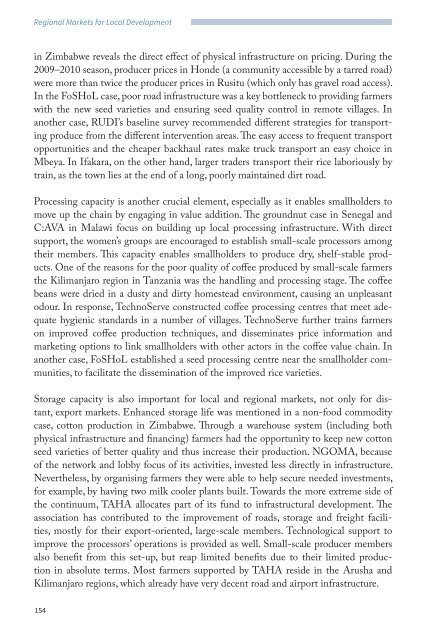Regional Markets
56ec00c44c641_local-markets-book_complete_LR
56ec00c44c641_local-markets-book_complete_LR
Create successful ePaper yourself
Turn your PDF publications into a flip-book with our unique Google optimized e-Paper software.
<strong>Regional</strong> <strong>Markets</strong> for Local Development<br />
in Zimbabwe reveals the direct effect of physical infrastructure on pricing. During the<br />
2009–2010 season, producer prices in Honde (a community accessible by a tarred road)<br />
were more than twice the producer prices in Rusitu (which only has gravel road access).<br />
In the FoSHoL case, poor road infrastructure was a key bottleneck to providing farmers<br />
with the new seed varieties and ensuring seed quality control in remote villages. In<br />
another case, RUDI’s baseline survey recommended different strategies for transporting<br />
produce from the different intervention areas. The easy access to frequent transport<br />
opportunities and the cheaper backhaul rates make truck transport an easy choice in<br />
Mbeya. In Ifakara, on the other hand, larger traders transport their rice laboriously by<br />
train, as the town lies at the end of a long, poorly maintained dirt road.<br />
Processing capacity is another crucial element, especially as it enables smallholders to<br />
move up the chain by engaging in value addition. The groundnut case in Senegal and<br />
C:AVA in Malawi focus on building up local processing infrastructure. With direct<br />
support, the women’s groups are encouraged to establish small-scale processors among<br />
their members. This capacity enables smallholders to produce dry, shelf-stable products.<br />
One of the reasons for the poor quality of coffee produced by small-scale farmers<br />
the Kilimanjaro region in Tanzania was the handling and processing stage. The coffee<br />
beans were dried in a dusty and dirty homestead environment, causing an unpleasant<br />
odour. In response, TechnoServe constructed coffee processing centres that meet adequate<br />
hygienic standards in a number of villages. TechnoServe further trains farmers<br />
on improved coffee production techniques, and disseminates price information and<br />
marketing options to link smallholders with other actors in the coffee value chain. In<br />
another case, FoSHoL established a seed processing centre near the smallholder communities,<br />
to facilitate the dissemination of the improved rice varieties.<br />
Storage capacity is also important for local and regional markets, not only for distant,<br />
export markets. Enhanced storage life was mentioned in a non-food commodity<br />
case, cotton production in Zimbabwe. Through a warehouse system (including both<br />
physical infrastructure and financing) farmers had the opportunity to keep new cotton<br />
seed varieties of better quality and thus increase their production. NGOMA, because<br />
of the network and lobby focus of its activities, invested less directly in infrastructure.<br />
Nevertheless, by organising farmers they were able to help secure needed investments,<br />
for example, by having two milk cooler plants built. Towards the more extreme side of<br />
the continuum, TAHA allocates part of its fund to infrastructural development. The<br />
association has contributed to the improvement of roads, storage and freight facilities,<br />
mostly for their export-oriented, large-scale members. Technological support to<br />
improve the processors’ operations is provided as well. Small-scale producer members<br />
also benefit from this set-up, but reap limited benefits due to their limited production<br />
in absolute terms. Most farmers supported by TAHA reside in the Arusha and<br />
Kilimanjaro regions, which already have very decent road and airport infrastructure.<br />
154


